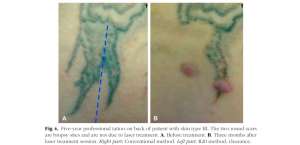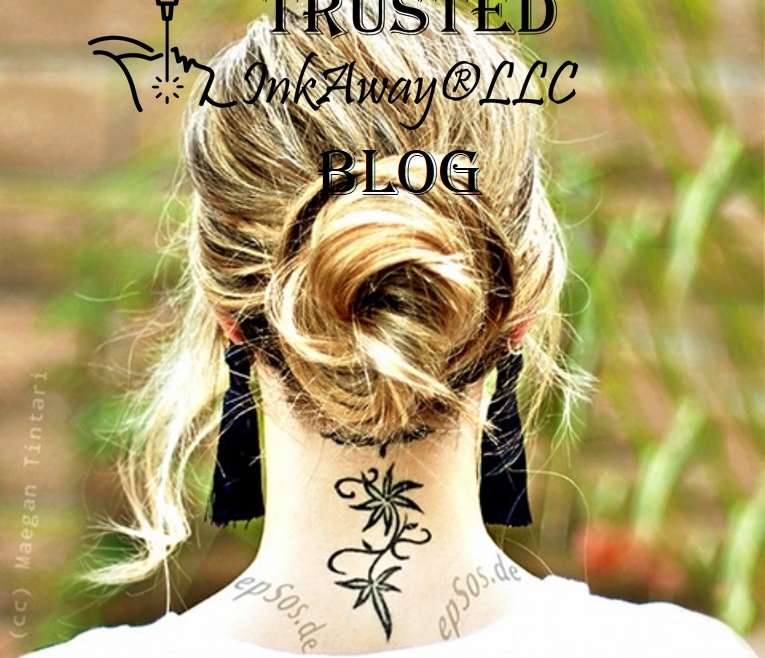Multiple treatment sessions are usually required to obtain acceptable tattoo lightening with the conventional laser tattoo removal protocol. Laser treatments are typically spaced 1 to 2 months apart. The Kirby-Desai method could only give a rough estimation on the total required treatment visits by ignoring many significant impact factors including life styles and responses of immune system. Customers are not satisfied with the uncertainty of visits, the long time necessary to achieve enough lightening, and the high cost associated with the conventional laser tattoo removal process. At TrustedInkAway, we value our customer’s satisfaction. The motivation for us to provide modified R20 treatment protocol to every single-visit customer is to address the critics of our customers and make them satisfied as much as we can. Thus, we decide to offer our modified R20 treatment modality for every qualified customer. Additionally, we want to remove the uncertainty in the total amount of payments by offering free and unlimited treatments when your total treatment visits have reached the estimated number made during your free consultation session. In the following paragraphs, we will discuss what is our modified R20 protocol and how it can speed up your tattoo removal process, reduce total visits and save your money. Before we discuss the protocols, we can fast forward to see the amazing result of R20 protocol in the figure below. Left image in the figure was taken before treatment and the right image in the figure was taken three months after the laser treatment. Inks on the left of the blue dash line were fully removed with R20 protocol while the inks on the right of the blue dash line were only lightened to a certain extent with conventional protocol.
 Let’s discuss the protocols again. R20/R0 laser tattoo removal protocols are tattoo removal methods based on repeated laser exposures in a single visit with 20 minutes or 0 minutes between laser exposures. The R20 protocol was first reported by Dr. Kossida in his paper [1] published by Journal of American Academy Dermatology in 2012. In Dr. Kossida’s study, 18 tattoos were divided in half randomly. One half was treated with repeated laser exposures of R20 protocol while another half was treated with a single laser exposure of conventional protocol. Immediate whitening reaction occurred on the first treatment pass, with little or no whitening on subsequent passes. Three months later, treatment with the R20 method was much more effective than conventional single-pass laser treatment. For example, tattoos on the left of the blue dash line in the before image were treated with R20 protocol and tattoos on the right side of the blue dash line were conventional protocol. Despite greater epidermal injury with the R20 method, neither method caused adverse events or scarring. Light microscopy showed greater dispersion of tattoo ink with the R20 method. The R0 protocol was reported by Dr. Reddy in his paper [2] published by the journal of Lasers in Surgery and Medicine in 2013. It is essentially an improved protocol that utilizes PFD (perfluorodecalin) to quickly remove whitening effect instead of waiting 20 minutes between repeated laser exposures. Dr. Reddy demonstrated equal fading of tattoos for R20 and R0 protocols. However, no dark skin types V or VI were included in the study. For customer with keloid scar, repeated laser exposure may present a significantly larger risk of scarring. Thus, our modified R20 protocol is more conservative considering the potential risks associated with repeated laser exposures in darker skin types. We also exclude customers with keloid scars as potential candidates for our modified R20 protocol. In our modified R20 protocol, N (N>=2) times of repeated exposures are performed with 20 minutes between laser exposures with N depending on the customer’s Fitzpatrick skin type and other risk factors.
Let’s discuss the protocols again. R20/R0 laser tattoo removal protocols are tattoo removal methods based on repeated laser exposures in a single visit with 20 minutes or 0 minutes between laser exposures. The R20 protocol was first reported by Dr. Kossida in his paper [1] published by Journal of American Academy Dermatology in 2012. In Dr. Kossida’s study, 18 tattoos were divided in half randomly. One half was treated with repeated laser exposures of R20 protocol while another half was treated with a single laser exposure of conventional protocol. Immediate whitening reaction occurred on the first treatment pass, with little or no whitening on subsequent passes. Three months later, treatment with the R20 method was much more effective than conventional single-pass laser treatment. For example, tattoos on the left of the blue dash line in the before image were treated with R20 protocol and tattoos on the right side of the blue dash line were conventional protocol. Despite greater epidermal injury with the R20 method, neither method caused adverse events or scarring. Light microscopy showed greater dispersion of tattoo ink with the R20 method. The R0 protocol was reported by Dr. Reddy in his paper [2] published by the journal of Lasers in Surgery and Medicine in 2013. It is essentially an improved protocol that utilizes PFD (perfluorodecalin) to quickly remove whitening effect instead of waiting 20 minutes between repeated laser exposures. Dr. Reddy demonstrated equal fading of tattoos for R20 and R0 protocols. However, no dark skin types V or VI were included in the study. For customer with keloid scar, repeated laser exposure may present a significantly larger risk of scarring. Thus, our modified R20 protocol is more conservative considering the potential risks associated with repeated laser exposures in darker skin types. We also exclude customers with keloid scars as potential candidates for our modified R20 protocol. In our modified R20 protocol, N (N>=2) times of repeated exposures are performed with 20 minutes between laser exposures with N depending on the customer’s Fitzpatrick skin type and other risk factors.
Although the exact mechanism is unknown, R20/R0 protocols are far more efficient in removing tattoos as demonstrated by the above two studies. One hypothesis is that repeated laser exposures allow laser to break up ink at deeper depths when inks at shallower depths have been dispersed by previous laser exposures and more laser energy can be deposited into deeper inks. That is exactly why TrustedInkAway’s modified R20 protocol can speed up your laser tattoo removal process. With the modified R20 protocol, your tattoos can be safely removed with much less visits than required by the conventional protocol. And the reduced visits result in significantly less total amount of money out of your pocket and satisfied customers.
References
[1] Theodora Kossida, et. al, “Optimal tattoo removal in a single laser session based on the method of repeated exposures” J Am Acad Dermatol, 66(2), pp 271-277, 2012.
[2] Kavitha K. Reddy, et. al, “Topical Perfluorodecalin Resolves Immediate Whitening Reactions and Allows Rapid Effective Multiple Pass Treatment of Tattoos” Lasers in Surgery and Medicine 45:76-80, 2013.

